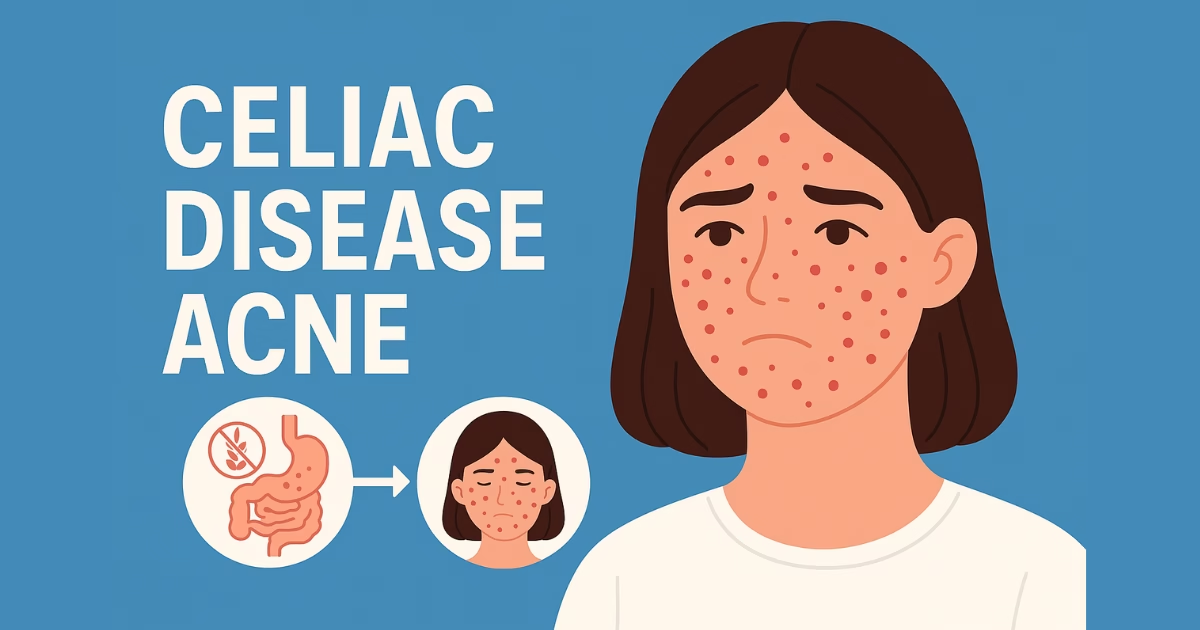Celiac disease is a serious autoimmune disorder that affects how the body reacts to gluten, a protein found in wheat, barley, and rye. People with this condition often face digestive issues like bloating, diarrhea, and stomach pain. But what many don’t realize is that celiac disease can also impact skin health. One surprising concern is what’s often referred to as celiac disease acne. While acne is usually linked to clogged pores and bacteria, those with celiac disease may notice breakouts triggered by inflammation or nutrient deficiencies caused by gluten damage in the gut. This connection between celiac disease and acne is becoming a growing topic of interest, especially for those seeking answers about persistent skin problems. In this article, we will explore how celiac disease acne happens, what makes it different from regular acne, and how people can manage it effectively for clearer skin and better overall health.
What Is Celiac Disease Acne?
Celiac disease acne is a term used to describe acne-like breakouts that some people with celiac disease experience. Although celiac disease is best known for its digestive symptoms, it can also have effects far beyond the gut. One of these effects includes skin issues that may look like typical acne. This condition isn’t a medical diagnosis on its own but rather a way to describe acne that might be linked to celiac disease or gluten sensitivity.
Unlike common acne, which is often caused by bacteria and oil build-up, celiac disease acne can be related to inflammation inside the body. Gluten exposure may trigger immune responses that cause breakouts or worsen existing acne. It’s also important to know that some skin rashes, such as dermatitis herpetiformis, are closely tied to celiac disease but can be mistaken for acne. Understanding the difference is key to getting the right treatment and improving both skin and gut health.
How Celiac Disease Can Lead to Acne
Celiac disease is an autoimmune condition, which means the body’s immune system attacks its own tissues when gluten is consumed. This attack creates inflammation, not just in the gut but all over the body. Inflammation is a well-known cause of many skin issues, including acne. When someone with celiac eats gluten, their body reacts, and this can sometimes show up on their skin.
There’s also something called the gut-skin connection. A damaged gut, common in people with celiac disease, can lead to toxins and bacteria leaking into the bloodstream. This might cause flare-ups of acne or other skin problems. Gluten can trigger hormonal changes too, which may add to acne breakouts. Though not everyone with celiac disease will have acne, these factors help explain why some do.
Nutrient Deficiencies and Skin Problems
Another key reason for acne in people with celiac disease is poor nutrient absorption. When the small intestine is damaged by gluten, it struggles to take in vital nutrients. Some of these, like zinc, vitamin A, and vitamin D, are very important for healthy skin.
Zinc helps fight bacteria and keeps oil production in balance. A lack of zinc can lead to breakouts that are hard to control. Vitamin A supports skin cell growth and repair, and vitamin D helps reduce inflammation. Without enough of these nutrients, the skin can become dry, irritated, and prone to acne. That’s why many people with celiac disease who don’t manage their diet well often notice skin troubles alongside other symptoms.
Other Skin Conditions Confused with Acne
It’s easy to mistake other skin conditions for acne, especially when celiac disease is involved. One of the most common is dermatitis herpetiformis. This is a bumpy, itchy rash that looks a bit like acne but is actually a sign of celiac disease. It usually appears on elbows, knees, or the back, not so much the face.
Other conditions, like eczema or rosacea, can also be confused with acne. These skin problems might show redness, bumps, or even pimples, making it hard to tell them apart. That’s why seeing a doctor or dermatologist is important. They can do tests or take skin samples to make sure the right diagnosis is made.
Can a Gluten-Free Diet Clear Up Acne?
For many people with celiac disease, switching to a strict gluten-free diet is the main treatment. But can it really help clear acne too? Some research says yes, but results vary. Removing gluten stops the autoimmune attack and allows the gut to heal. This can lower inflammation, which might improve acne over time.
A gluten-free diet also helps the body absorb nutrients better, which supports healthy skin. However, it’s not an overnight fix. Some people notice changes in a few weeks, while others might take months. And for people without celiac disease, there’s little proof that going gluten-free alone will solve acne problems. Still, many personal stories suggest clearer skin as a bonus of living gluten-free.
Tips to Manage Celiac Disease Acne
Managing celiac disease acne takes a mix of good diet and smart skincare. First, sticking to a strict gluten-free diet is key. No cheating—small amounts of gluten can still cause damage. Eating foods rich in skin-friendly nutrients like zinc, vitamin A, and healthy fats can also help.
For skincare, gentle products are best. Avoid harsh scrubs or oily creams that can clog pores. Look for non-comedogenic (won’t block pores) labels. Washing the face twice a day and keeping hands off the face are simple but powerful habits.
Seeing a doctor to check nutrient levels is also a good idea. Sometimes, taking supplements is needed to fix deeper skin issues. A dermatologist can also suggest acne treatments that are safe for sensitive, celiac-prone skin.
Mistakes to Avoid When Treating Acne with Celiac Disease
One common mistake is relying only on face creams and ignoring diet. For people with celiac disease, no amount of skin treatment will fully work if gluten is still damaging the gut. Another mistake is using harsh skincare products. These can make inflammation worse.
Some people think gluten-free skincare is a must, but this isn’t always true. Gluten can’t be absorbed through the skin unless there’s an open wound. Still, it’s smart to be cautious, especially with lip products that might be swallowed. Lastly, don’t skip regular check-ups. Skin issues can be a clue that something deeper needs attention.
When to Seek Medical Advice
Not all acne is caused by celiac disease, and not all rashes are harmless. If breakouts are painful, spreading fast, or not improving with gluten-free living, it’s time to see a doctor. A dermatologist can help figure out if it’s acne, dermatitis herpetiformis, or something else.
For those who haven’t been diagnosed but suspect gluten might be a problem, getting tested for celiac disease is a smart step. Sometimes, skin symptoms are the first sign of a bigger issue. A dietitian can also help plan meals that support both gut and skin health.
Conclusion
Celiac disease acne shows how deeply connected the gut and skin really are. While not everyone with celiac disease will have acne, many do notice skin problems that improve once gluten is removed from their diet. The combination of healing the gut, getting enough nutrients, and using gentle skincare can make a big difference. Understanding the link between celiac disease and acne helps people take better care of both their skin and their overall health. With the right steps, clearer skin and a healthier life are possible.
FAQ
1. Can celiac disease cause acne?
Yes, celiac disease can lead to acne-like breakouts due to inflammation, poor gut health, and nutrient deficiencies.
2. What skin conditions are linked to celiac disease?
The most common is dermatitis herpetiformis, but other issues like eczema, psoriasis, and acne may also appear.
3. Will a gluten-free diet clear my acne?
For people with celiac disease, a gluten-free diet may reduce inflammation and improve acne over time.
4. How long does it take to see skin improvements after going gluten-free?
Some notice changes within weeks, but full skin healing may take several months as the gut repairs.
5. Do I need gluten-free skincare products?
Not usually, as gluten can’t be absorbed through the skin, but be cautious with lip products to avoid swallowing gluten.

Hi, I’m Shafy Ali – a curious mind and passionate writer at Celiac Magazine. I cover a little bit of everything, from everyday tips and how-tos to deeper dives into topics that spark conversation. I enjoy turning research into readable, relatable content that informs and inspires. Whatever the subject, I aim to keep it clear, engaging, and genuinely useful.

